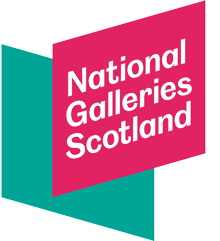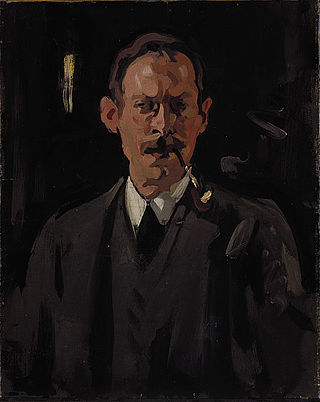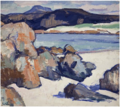
The National is the national art gallery of Scotland. It is located on The Mound in central Edinburgh, close to Princes Street. The building was designed in a neoclassical style by William Henry Playfair, and first opened to the public in 1859.

Modern art includes artistic work produced during the period extending roughly from the 1860s to the 1970s, and denotes the styles and philosophies of the art produced during that era. The term is usually associated with art in which the traditions of the past have been thrown aside in a spirit of experimentation. Modern artists experimented with new ways of seeing and with fresh ideas about the nature of materials and functions of art. A tendency away from the narrative, which was characteristic of the traditional arts, toward abstraction is characteristic of much modern art. More recent artistic production is often called contemporary art or Postmodern art.
The Scottish Colourists were a group of four painters, three from Edinburgh, whose Post-Impressionist work, though not universally recognised initially, came to have a formative influence on contemporary Scottish art and culture. The four artists, Francis Cadell, John Duncan Fergusson, Leslie Hunter and Samuel Peploe, were prolific painters spanning the turn of the twentieth century until the beginnings of World War II. While now banded as one group with a collective achievement and a common sense of British identity, it is a misnomer to believe their artwork or their painterly careers were heterogeneous.

The National Galleries of Scotland is the executive non-departmental public body that controls the three national galleries of Scotland and two partner galleries, forming one of the National Collections of Scotland.

Sir Eduardo Luigi Paolozzi was a Scottish artist, known for his sculpture and graphic works. He is widely considered to be one of the pioneers of pop art.

Modern Two, formerly the Dean Gallery, in Edinburgh, is one of the two buildings housing the Scottish National Gallery of Modern Art, one of Scotland's national art galleries. It is operated by National Galleries Scotland. It is twinned with Modern One which lies on the opposite side of Belford Road.

The Royal Botanic Garden Edinburgh (RBGE) is a scientific centre for the study of plants, their diversity and conservation, as well as a popular tourist attraction. Founded in 1670 as a physic garden to grow medicinal plants, today it occupies four sites across Scotland—Edinburgh, Dawyck, Logan and Benmore—each with its own specialist collection. The RBGE's living collection consists of more than 13,302 plant species, whilst the herbarium contains in excess of 3 million preserved specimens.

Charles Alexander Jencks was an American cultural theorist, landscape designer, architectural historian, and co-founder of the Maggie's Cancer Care Centres. He published over thirty books and became famous in the 1980s as a theorist of postmodernism. Jencks devoted time to landform architecture, especially in Scotland. These landscapes include the Garden of Cosmic Speculation and earthworks at Jupiter Artland outside Edinburgh. His continuing project Crawick Multiverse, commissioned by the Duke of Buccleuch, opened in 2015 near Sanquhar.

John Duncan Fergusson was a Scottish artist and sculptor, regarded as one of the major artists of the Scottish Colourists school of painting.

Samuel John Peploe was a Scottish Post-Impressionist painter, noted for his still life works and for being one of the group of four painters that became known as the Scottish Colourists. The other colourists were John Duncan Fergusson, Francis Cadell and Leslie Hunter.
Christine Borland is a Scottish artist. Born in Darvel, Ayrshire, Scotland, Borland is one of the Young British Artists (YBAs) and was nominated for the Turner Prize in 1997 for her work From Life at Tramway, Glasgow. Borland works and lives in Kilcreggan, Argyll, as a BALTIC Professor at the BxNU Institute of Contemporary Art.
The Royal Glasgow Institute of the Fine Arts (RGI) is an independent organisation in Glasgow, founded in 1861, which promotes contemporary art and artists in Scotland. The institute organizes the largest and most prestigious annual art exhibition in Scotland - open to all artists.

Inverleith House is a historic house, now within the Royal Botanic Garden, in the suburb of Inverleith, in Edinburgh, Scotland.

Art in modern Scotland includes all aspects of the visual arts in the country since the beginning of the twentieth century. In the early twentieth century, the art scene was dominated by the work of the members of the Glasgow School known as the Four, led by Charles Rennie Mackintosh, who gained an international reputation for their combination of Celtic revival, Art and Crafts and Art Nouveau. They were followed by the Scottish Colourists and the Edinburgh School. There was a growing interest in forms of Modernism, with William Johnstone helping to develop the concept of a Scottish Renaissance. In the post-war period, major artists, including John Bellany and Alexander Moffat, pursued a strand of "Scottish realism". Moffat's influence can be seen in the work of the "new Glasgow Boys" from the late twentieth century. In the twenty-first century Scotland has continued to produce influential artists such as Douglas Gordon and Susan Philipsz.

The Artist as Hephaestus is a bronze statue by Sir Eduardo Paolozzi, created in 1987. It depicts a standing human figure, a self-portrait of Paolozzi 2.64 metres tall, with the left foot advanced as if walking, holding two pierced objects akin to sieves.

Newton, sometimes known as Newton after Blake, is a 1995 work by the sculptor Eduardo Paolozzi. The large bronze sculpture is displayed on a high plinth in the piazza outside the British Library in London.
Gabrielle Muriel Keiller was a Scottish golfer, art collector, archaeological photographer and heir to Keiller's marmalade in Dundee. She bequested a large collection of Dada and Surrealist art to the Scottish National Gallery of Modern Art.
Victoria Morton is a Scottish contemporary visual artist who works in paint, sculpture and installation.

The City Art Centre is part of the Museums & Galleries Edinburgh, which sits under the Culture directorate of the City of Edinburgh Council. The City Art Centre has a collection which include historic and modern Scottish painting and photography, as well as contemporary art and craft. It is an exhibition based venue with no permanent displays.

Cornelia Wadsworth Ritchie Adair was a Texas ranch landowner.






































